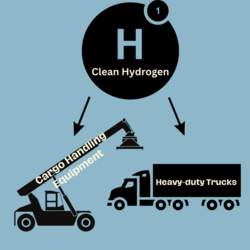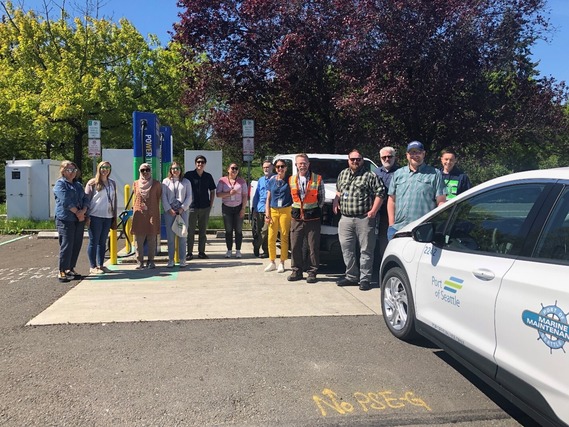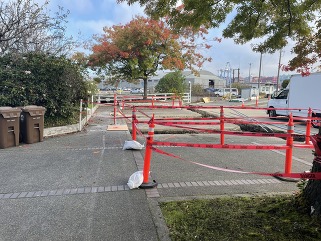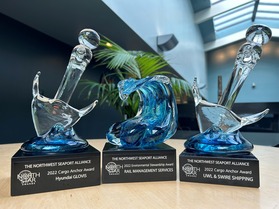|
Welcome to Clean Air Quarterly, a newsletter from the Ports of Seattle, Tacoma, and the Northwest Seaport Alliance sharing clean air and climate efforts in our regional gateway. Each issue of the newsletter showcases projects and milestones across our gateway, features a team member or gateway partner who is making a difference in our region, and highlights upcoming opportunities for engaging with many aspects of the Ports environment, including bus tours, commission meetings, webinars, and events!

In October the Biden Administration announced the selection of seven regional hydrogen hubs to receive a collective $7 billion in funding though the U.S. Department of Energy (DOE) Office of Clean Energy Demonstrations (OCED). The Pacific Northwest Hydrogen Hub was selected as one of those awarded for up to $1 billion in funding and in which the NWSA is a partner. This is an exciting first step into developing clean energy hydrogen infrastructure for our region and for our ports.
Hydrogen is the most abundant element in the universe and is a gas (H2) at room temperature and pressure. It is currently used as an input to a variety of industrial processes and recently has been gaining traction as a transportation fuel, particularly in applications where battery electric technologies may not have enough range, or where charging times can’t be accommodated. The NWSA’s proposed project as a part of this hub envisions using clean hydrogen as a fuel to power heavy-duty vehicles that serve maritime facilities, like drayage trucks and cargo handling equipment.
For hydrogen to be low carbon it must be produced without using fossil fuels, or utilizing carbon capture technology. One way to make hydrogen is to use an electrical current to split the “H2” from the “O” in water, a process called electrolysis. If solar, wind or other renewable sources of energy are used to produce the hydrogen, then the product can be low or zero carbon, otherwise known as “green” hydrogen.
You can read more on the announcement here and here.
|
 The Port of Seattle aims to adopt zero-emission vehicles (EV) or use renewable fuels in its passenger fleet vehicles by 2030. The fleet includes light-duty sedans, trucks, and vans. The Port’s Marine Maintenance team is making progress toward this goal by purchasing renewable diesel that will fuel all vehicles and equipment onsite while also purchasing EVs where available.
The Port of Seattle recently introduced a Ford F-150 Lightning Electric Truck, a Volkswagen ID.4, and a Chevrolet Bolt into its maritime fleet. The Port has a project underway to install EV charging at its Marine Maintenance facility and is planning to expand EV charging to support fleet electrification across its properties. Earlier this year, Port of Seattle staff visited one of Seattle City Light’s public Level 3 electric vehicle (EV) charging stations to learn more about how to design an EV charging station. Level 3 chargers are also known as fast chargers and can recharge a light-duty EV in half an hour.

In the South Harbor, the Port of Tacoma is also making investments in fleet electrification. The first step is ensuring that the charging infrastructure is available to support the powering of the electric fleet.
The Port of Tacoma Commission approved the installation of charging infrastructure and broke ground in September on the first EV charging station at the Port Administration Building. The Port is installing six charging stations to support its first electric fleet vehicles, which are expected to arrive in spring 2024. These first electric vehicles in the port’s fleet will be used to move staff to facilities across the Tideflats and is a substantial first step to electrify the port’s fleet.
|
The Pier 66 Shore Power Project is advancing an innovative solution to bring shore power to the downtown waterfront cruise terminal at Pier 66. A submarine cable was delivered to Terminal 46 last summer where it will receive a clean power source from Seattle City Light. The duct bank work at Terminal 46, where Seattle City Light will help supply power to the submarine cable, is underway. The cable will be installed in early 2024, followed by the delivery of a large transformer in the spring. Once the transformer is connected, the power and cable will be tested and commissioned. The first ship will plug in during the 2024 cruise season.
This project will significantly reduce greenhouse gas emissions from cruise vessels at berth, allowing them to plug into shore power and turn off diesel engines. It will improve air quality for everyone, including maritime workers and local residents. The double-berth cruise terminal at Port of Seattle’s Terminal 91 has had shore power at both berths since 2009. The Port has seen an increase in the number of ships equipped with shore power and connecting each season. Based on data collected through September, 96 cruise calls have plugged in at Terminal 91 this year. The completion of shore power at Pier 66 will mean that all three of Port of Seattle’s cruise berths offer a shore power connection, an important step toward phasing out seaport-related emissions by 2050.
 The U.S. Federal Railroad Administration announced two investments in Washington state’s rail system to improve efficiency and reduce greenhouse gas emissions. The $76.8 million infrastructure investment will bring the first zero-emissions battery-electric locomotives to Washington state. The investment focuses on major improvements to the Palouse River & Coulee City Railroad (PCC), a 297-mile rail route critical to the movement of agricultural goods to our harbors, and to Tacoma Rail.
The Tacoma Rail project will remove two circa 1965 diesel-electric locomotives from active service and replace them with two zero-emissions battery-electric locomotives. The two diesel engines will be scrapped and result in an annual reduction of approximately 65,000 gallons of diesel fuel consumed in rail operations and eliminate an estimated 1,240 pounds of diesel particulate matter from our shared airshed. The investment will also include charging infrastructure for the new battery-electric locomotives.
The deployment of the zero-emissions locomotives will benefit shippers' who are increasingly looking to make their supply chain operations more environmentally sustainable.

On October 12th the NWSA hosted their annual North Star Awards. One category of these awards is the Environmental Stewardship Award which recognizes companies for promoting environmental sustainability and taking measures that support the continued health of our region’s environment, and awarding those who take the step in helping us implement the Northwest Ports Clean Air Strategy and bring our gateway closer to achieving our goals. Rail Management Services (RMS), one of America’s largest intermodal terminal operators was awarded this year’s Environmental Stewardship Award for their investment in zero-emission cargo handling equipment in the South Harbor.
Ed Morgenthaler, VP of Safety & Maintenance with RMS noted “There are several advantages to running electric equipment, and several key components of these projects that are important, not just to purchasing and helping the environment, but from an operational perspective as well. The maintenance costs are lower, there is no fuel being purchased for this equipment. The overall operation, the overall functionality of this equipment is much easier.”
Over its life span, this project will remove an estimated four million pounds of CO2 emissions which is a big first step for modeling zero-emission cargo handling equipment in the NWSA gateway. Ed Morgenthaler said it best, when it comes to investments in clean energy “You have to think beyond tomorrow.”
Watch a video on RMS and their investment here.
|

Ryann Child is an Environmental Program Manager at Port of Seattle. As part of the Port's Maritime Environment & Sustainability department, Ryann is responsible for designing and implementing clean air and climate action programs to reduce air and greenhouse gas (GHG) emissions from Port of Seattle’s maritime operations.
Ryann joined Port of Seattle in January 2020, right before the onset of the COVID-19 pandemic. She supported the 2020 renewal of the Northwest Ports Clean Air Strategy and developed the Port’s first ever Maritime Climate and Air Action Plan.
Today, Ryann works on a wide variety of projects:
Ryann holds a B.A. in Environmental Science and Policy from Duke University. Originally from Bend, Oregon, she moved to Seattle after college for an AmeriCorps internship at Cascade Bicycle Club where she advocated for safe and accessible bicycle infrastructure projects and outreach to businesses to increase bike commuting. Ryann spent six years working in environmental consulting where her interests at the intersection of public health, climate change, and transportation broadened beyond bicycling as her experience grew to include clean ports and freight, climate change and clean energy, and environmental public health, including supporting a Clean Air Strategy for the Port Authority of New York and New Jersey.
Outside of work, Ryann enjoys running, biking, and playing competitive Ultimate Frisbee. She still prefers to commute to work by bike. You can reach out to her directly: child.r@portseattle.org
|
|